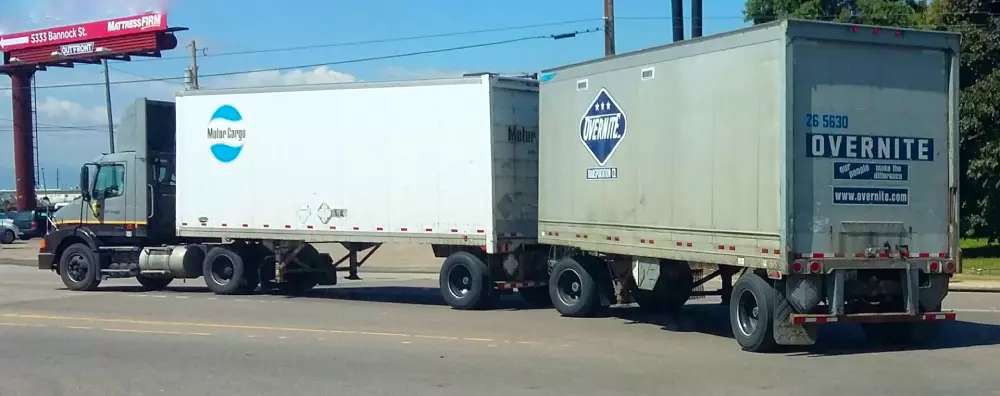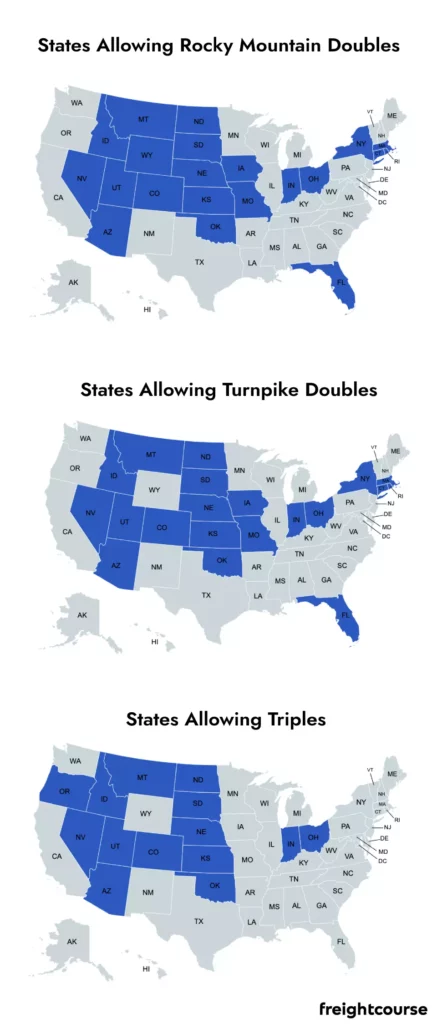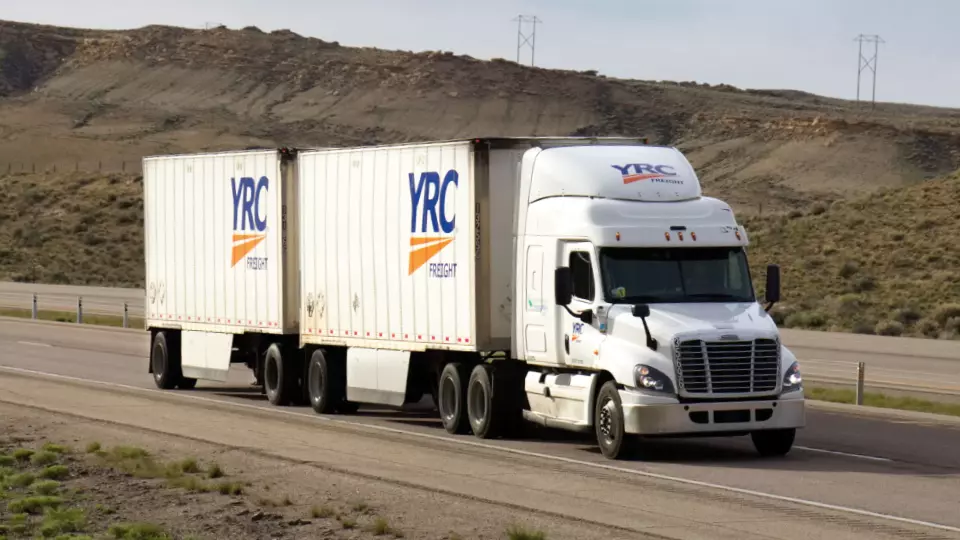When it comes to transporting cargo, semi trucks are typically attached to a single trailer. However, with the use of converter dollies, it is possible for semi trucks to connect to multiple trailers in sequence.
This practice is also known as doubles and triples in the trucking industry and has become increasingly popular, as it allows for more goods to be transported in a single trip, improving efficiency and reducing transportation costs.
For example, double trucking has become a common sight on highways across the United States, while triple trucking is permitted on certain highways in both the US and Canada.
In this article, we’ll dive deeper into the concept of doubles and triples, and elaborate on the benefits and risks involved. We’ll also share insights on the respective regulations and training requirements for drivers looking to haul multiple trailers in sequence.
What Are Doubles and Triples in Trucking?
Doubles and triples are two variants of semi-truck and trailer connections. They’re commonly known as longer combination vehicles (LCVs). As the term suggests, doubles refer to two trailers attached to a single semi-truck. On the other hand, triples refer to three trailers attached to a single semi.

The first trailer in either arrangement is connected to a semi with a fifth wheel coupling. The subsequent trailers are connected using a converter dolly. A converter dolly is a specialized coupling device comprising one to three axles, brakes, drawbar(s), a hitch, and a fifth wheel of its own.
Today, you can find two different types of converter dollies – A-dolly and C-dolly. An A-dolly is the most commonly found type of converter dolly which comprises a single drawbar with a coupling mechanism in the center. Meanwhile, a C-dolly has two independent couplings side-by-side.
Doubles and triples are almost always longer than a single tractor-trailer combination, depending on the trailer size. Moreover, the multiple coupling and uncoupling mechanisms require specialized training and expertise to operate safely and efficiently.
Drivers must also undergo extensive handling and maneuvering training to adjust to the new configuration, increased stopping distance, longer turns, and other changes. Some of these combinations include rocky mountain double, turnpike double, B-train double, and triple trailer.
Moreover, since doubles and triples are used to transport large quantities of cargo over long distances, drivers may also have to adjust to longer driving periods per trip or haul multiple empty trailers to drop yards when offering drop-trailer services.
Regulations for Doubles & Triples
Due to the increased difficulty of operating longer vehicles, not every driver with a commercial driver’s license can haul doubles or triples. Drivers looking to haul multiple trailers need to get a separate commercial driver’s license (CDL) for doubles and triples with endorsement by taking a test to prove competency and understanding max weight and length requirements in different states.
Below is a list that shows which states allow Rocky Mountain Doubles, Turnpike Doubles, and Triples. While we strive to bring you the most up-to-date and accurate information, we recommend that you check the location regulations where you operate independently. Please use the below illustration only as a reference.

Maximum Weight & Length
According to the Federal Highway Administration, most US states limit the lengths of LCVs to 110 feet for double-trailer combinations and 115.5 feet for triple-trailer combinations. Moreover, the maximum weight allowed depends on the number of axles on the trailers.
For instance, a 7-axle rocky mountain double-trailer allows up to 120,000 pounds gross weight. At the same time, an 8-axle B-train double-trailer hauls 124,000 pounds and a 9-axle turnpike double-trailer hauls up to 148,000 pounds. Meanwhile, a triple-trailer combination typically hauls up to 132,000 pounds gross weight.
Doubles and Triples CDL Test
As mentioned above, drivers need a separate CDL to haul doubles and triples. Therefore, depending on the endorsement type, they have to take a test containing 20 to 30 questions. Moreover, candidates need to score at least 80% to pass. A typical doubles and triples CDL test is based on the following topics:
- Regulatory Obligations – Regulatory obligations include safety regulations, maximum lengths and weights, safety procedures & equipment, among other details.
- Sequencing of Trailers – Sequencing of trailers refers to planning weight distribution across multiple trailers and adjusting the fifth wheel and axles accordingly.
- Coupling and Uncoupling – Coupling and uncoupling are recurring aspects of hauling doubles and triples. Therefore, drivers must know how to safely hook and unhook multiple trailers, align the trailers, and connect the airlines, electrical cables, etc. Furthermore, they need to be able to inspect the connections for issues and fix them accordingly.
- Maneuvering – Drivers need to be able to navigate turns accurately and safely as the turning radius for longer combination vehicles is significantly larger. They must also learn backing maneuvers with multiple trailers, adjust to a new braking distance, and compensate for off-tracking.
- Inspection and Maintenance – Apart from the fifth-wheel and converter dollies, drivers need to know how to inspect the trailers’ brakes, tires, lights, and other essential components.
Practice Tests
A pre-requisite of securing a CDL for doubles and triples involves practice tests before the actual test. As expected, these tests are much more intimidating and challenging than conventional CDL tests. However, they help drivers gain an understanding proactively, practice new driving techniques, and practice for the real test.
Doubles and Triples Endorsement
Today, there are different kinds of tests required for specialized endorsements. As a result, drivers looking to haul doubles and triples would need to pass a specific test to obtain the endorsement they need and complete the final mandatory step before they can transport multiple trailers legally.
Below is a list of endorsements, along with their description and a guide to obtaining them:
| Type | Description | How to Obtain |
| T | Endorsement for two or three standard trailers. | Pass a written knowledge test specific to the respective endorsement type. |
| N | Endorsement for tankers transporting non-hazardous gas, water, chemicals, etc. | |
| P | Endorsement for transporting passengers on commercial vehicles. | |
| S | Endorsement for operating a school bus. | Have a “P” endorsement and pass a written knowledge test. |
| H | Endorsement for transporting hazardous materials like chemicals, gas, and oil in drums, ISO tanks, and other HazMat packaging. | Pass a written knowledge test and undergo a Transportation Security Administration (TSA) threat assessment. |
| X | Endorsement for transporting hazardous materials like chemicals, gas, and oil in tankers. | Pass the written knowledge tests for both H and N endorsements. |
Coupling & Uncoupling Doubles and Triples Trailers
Coupling and uncoupling refer to the process of connecting and disconnecting trailers from a semi-truck. Coupling multiple trailers can prove to be challenging. Here’s a comprehensive step-by-step guide explaining both processes.
Coupling Doubles & Triples
Before connecting a second or third trailer, check if it has working spring brakes. To do this, you need to drive your semi-truck within close proximity of your trailer and connect the emergency line.
Next, you need to charge the trailer air tank to set the emergency brakes. Secondly, you need to ensure that the trailers are hooked in descending weight order. In other words, the rear trailer should be the lightest.
Once you take care of these aspects, you simply need to form a double-bottom rig with your converter dolly with the following steps:
- Position the dolly in front of the rear trailer after releasing the dolly brakes in line with the kingpin. You can also use the tractor and first or second semi-trailer to hook and lock the dolly tongue.
- Once you connect the dolly to the front trailer, you must lock and secure the pintle hook.
- Next, check the coupling and ensure there’s no space between the fifth wheel and the locking jaws. Once you’re done, connect the light cords, safety chains, and other accessories.
- Finally, raise the landing gear and check if the brakes are working.
Uncoupling Doubles & Triples
To uncouple the rear trailer, follow the steps below:
- Park the truck on firm, level ground, and make sure you apply the parking brakes.
- Lower the second or third trailer’s landing gear to lighten some of the load off the dolly.
- Next, close the air shutoffs and disconnect all electric and air lines.
- Release the dolly brakes and slowly pull back on the fifth wheel latch to detach the trailer.
- Finally, drive the tractor (and first/second) semi-trailer forward and repeat the process if you’re hauling triples.
Benefits of Operating Doubles and Triples
While most truckers understand the concept of doubles and triples, only a few understand the short-term and long-term benefits of hauling multiple trailers simultaneously. Therefore, we’ll share the main benefits below:

- Improves Productivity – Hauling multiple trailers allows truckers to transport double or triple the amount using a single semi-truck. As a result, they can haul more cargo in a single trip. Secondly, doubles and triples allow truckers to offer drop-trailer services efficiently and leverage drop yards to store multiple trailers for improved productivity.
- Reduces Cost Per Mile – Doubles and triples reduce the need for bobtailing, allowing carriers to save on fuel. All these factors (and more) reduce the overall cost per mile for trucking companies and owner-operators.
- Allows Load Versatility – Doubles and triples enable carriers to hook different types of trailers (flatbed, reefers, etc.) to a single truck and haul various types of cargo simultaneously.
- More Environmentally Friendly – By reducing the number of trips and the cost per mile, carriers can reduce greenhouse gas emissions by hauling multiple trailers in a single trip.
Risks of Operating Doubles and Triples
Although doubles and triples offer great benefits to truckers, they’re not without a few risks, which we have expanded on below.
- Increased Safety Risks – Operating a truck that’s pulling two or three trailers requires longer stopping distances, which increases the risk of accidents. The increased difficulty of operating longer trucks poses various challenges, such as rollovers and jackknifing.
- Longer Travel Time – LCV operators are usually on the road much longer per trip than their counterparts. However, this isn’t simply because they’re transporting more cargo. It’s also due to the complexities of navigating tight turns or maneuvering the truck in urban areas and moving a much heavier vehicle. Due to state weight or size restrictions, many truckers have to take longer routes and spend more time on the road.
- Smaller Driver Selection Pool – Hauling multiple trailers safely and promptly requires specialized training, something not all drivers can do. As a result, carriers typically have a smaller pool of drivers to select from, especially for long-distance routes.

Get Free Course Access
If you enjoyed the article, don’t miss out on our free supply chain courses that help you stay ahead in your industry.

Andrew Lin
Co-Founder & Writer
at freightcourse
About the Author
Andrew is a multi-business owner with over 12 years of experience in the fields of logistics, trucking, manufacturing, operations, training, and education.
Being the co-founder of freightcourse has given him the ability to pursue his desire to educate others on manufacturing and supply chain topics.
Follow us